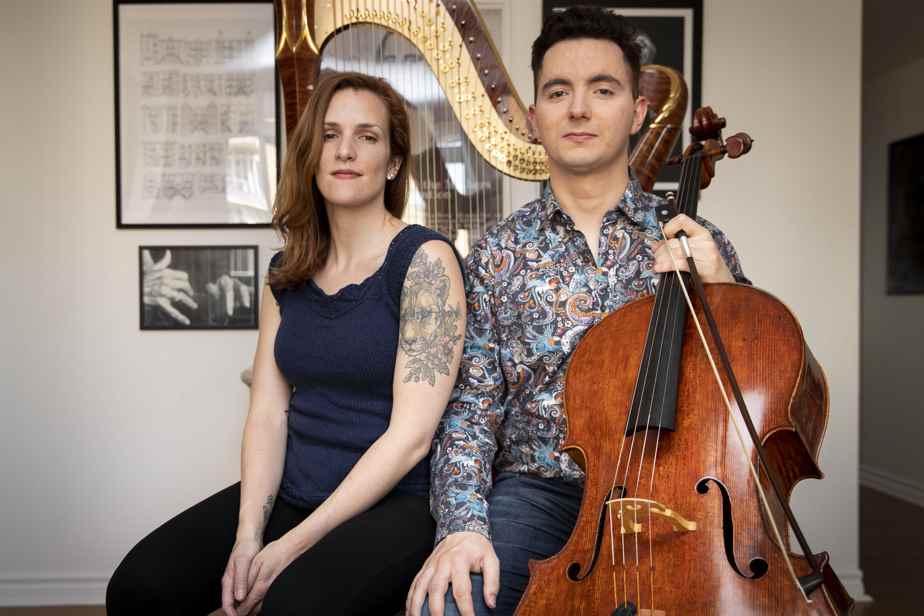Posted at 11:00 a.m.
“We called him Transfiguration because it’s a bit of the experience that the viewer can have when listening to music in general, but above all because of the fact that in this project you can experience a certain metamorphosis, both through the different themes and variations and through the use of harmonies and by the historical and visual context,” explains cellist Stéphane Tétreault, who, among others, we heard in solo with I Musici last winter.
Because there is as much for the ear as for the eyes in this program mainly composed of contemporary works that the two artists describe as a “concert-experience”.
“We will not hide the fact that playing contemporary music can frighten some broadcasters, concedes harpist Valérie Milot. But people in general embark a lot and are not badly challenged. It’s music that is very lively, that involves the listener a lot. The small layer of visuals that we add is just to further develop audience engagement. »
The staging and projections designed by the young musicians and their collaborators support the music without replacing it.
“It’s important that it adds something to the works, but that it doesn’t become so imposing that we lose the thread, concedes Stéphane Tétreault. Even if we remove the projections and everything, it’s still music that speaks a lot and tells a story. »
“It’s kind of an illustration of our friendship and our collaboration over the last 10 years, and also of how two people can come to terms with each other through music and everyday life,” he said. cellist.
“It’s a bit like the apotheosis of our collaboration, continues the latter. We started at a record launch where we were paired up and, eventually, we did a lot of duo and trio gigs. In 2019, we started doing a big brainstorm. And three years later, we have the pleasure of presenting it to the public. »
But the repertoire for harp and cello does not run the streets.
Two solutions then offered themselves to the duo: transcription or creation. With a common thread: no question of considering the cello as a solo instrument accompanied by the harp. The Milot-Tétreault duo brings together two partners in their own right.
The only concession to the traditional repertoire: the essential Swan taken from animal carnival by Saint-Saëns, which is the occasion for a musical commentary by the Quebec composer Alexandre Grogg, From one swan to anotherwhich also evokes Gibbons, Sibelius and Barber.
This is another work by Grogg which opens the disc, the Three variations on La Folia, originally written for jazz ensemble. These — like the transcription of Cogs in Cogs by Gentle Giant — involve drummer Bernard Riche, who is present at the concerts virtually.
François Vallières, who signs the transcription for cello and harp of Cogs in Cogsthere goes its own contribution with a Double-Monologue subtitled “Health Entertainment” composed during the pandemic.

PHOTO SARAH MONGEAU-BIRKETT, THE PRESS
Stéphane Tetreault and Valerie Milot
Add to it Close for Corridoran original 2013 composition by Caroline Lizotte, former teacher of Valérie Milot, and two pieces commissioned from renowned Canadian composers Kelly-Marie Murphy and Marjan Mozetich, respectively If veriash a la ranawhose music is taken from a concerto for harp and cello already performed by the two accomplices in Trois-Rivières in September 2020, and transfigured feelingwhich draws on the opera Madame Butterfly by Puccini.
Residencies with some of these creators during the pandemic allowed Stéphane Tétreault and Valérie Milot to be part of the creative process. A contact that the latter found simply “tripling”.
“You can better direct your interpretations by working with a composer”, says the one who teaches at the Conservatory of Music, adding that her own activity as a pedagogue is thereby reinforced. “It made me think a lot about how we approach historical works. We tend when we think of Claude Debussy, for example, to see him as a monument, but in fact, he is a human being who has evolved during his life. »
